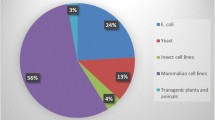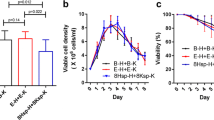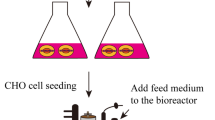Abstract
Hepatocyte growth factor (HGF) is an effective anti-fibrotic factor because of its bioactivity in inhibiting fibrosis-related proteins in the development of hepatic fibrosis. However, high-level production of bioactive mature form HGF is difficult because of its complex structure. Here, we report a non-fusion protein expression system to obtain truncated variant of N-terminal hairpin and first kringle domains of HGF (tvNK1) in Escherichia coli to determine its anti-fibrotic effects on hepatic stellate cells (HSCs). Under the selected conditions of cultivation and isopropyl-β-D-1-thiogalactopyranoside induction, the expression level of tvNK1 accounted for approximately 65 % of the total cellular protein and 50 % of fusion protein in the supernatant of whole cell lysates. The recombinant protein could be purified in one step with Ni2+-affinity chromatograph. Finally, about 65 mg recombinant tvNK1 was obtained from 1 l fermentation culture with no <95 % purity. In vitro, the final purified tvNK1 was shown to inhibit the proliferation of HSCs and decrease the mRNA and protein expression levels of fibrosis-related COL1A1 and α-smooth muscle actin genes.






Similar content being viewed by others
References
Baneyx F (1999) Recombinant protein expression in Escherichia coli. Curr Opin Biotechnol 10:411–421
Bataller R, North KE, Brenner DA (2003) Genetic polymorphisms and the progression of liver fibrosis: a critical appraisal. Hepatology 37:493–503
Cao P, Mei JJ, Diao ZY, Zhang S (2005) Expression, refolding, and characterization of human soluble BAFF synthesized in Escherichia coli. Protein Expr Purif 41:199–206
Cao P, Zhang S, Gong Z, Tang X, Cao M, Hu Y (2006) Development of a compact anti-BAFF antibody in Escherichia coli. Appl Microbiol Biotechnol 73:151–157
Dooley S, Delvoux B, Lahme B, Mangasser-Stephan K, Gressner AM (2000) Modulation of transforming growth factor beta response and signaling during transdifferentiation of rat hepatic stellate cells to myofibroblasts. Hepatology 31:1094–1106
Ghazwani M, Zhang Y, Gao X, Fan J, Li J, Li S (2014) Anti-fibrotic effect of thymoquinone on hepatic stellate cells. Phytomedicine 21:254–260
Kosai K, Matsumoto K, Nagata S, Tsujimoto Y, Nakamura T (1998) Abrogation of Fas-induced fulminant hepatic failure in mice by hepatocyte growth factor. Biochem Biophys Res Commun 244:683–690
Kosai K, Matsumoto K, Funakoshi H, Nakamura T (1999) Hepatocyte growth factor prevents endotoxin-induced lethal hepatic failure in mice. Hepatology 30:151–159
Liu H, Wang X, Wang C, Yuan X, Bao H, Fu X, Chu Y (2011) Molecular cloning, in vitro expression and bioactivity of rabbit transforming growth factor-beta receptor type II (rTGF-betaRII). Vet Immunol Immunopathol 140:55–62
Lokker NA, Mark MR, Luis EA, Bennett GL, Robbins KA, Baker JB, Godowski PJ (1992) Structure-function analysis of hepatocyte growth factor: identification of variants that lack mitogenic activity yet retain high affinity receptor binding. EMBO J 11:2503–2510
Mars WM, Liu ML, Kitson RP, Goldfarb RH, Gabauer MK, Michalopoulos GK (1995) Immediate early detection of urokinase receptor after partial hepatectomy and its implications for initiation of liver regeneration. Hepatology 21:1695–1701
Masunaga H, Fujise N, Shiota A, Ogawa H, Sato Y, Imai E, Yasuda H, Higashio K (1998) Preventive effects of the deleted form of hepatocyte growth factor against various liver injuries. Eur J Pharmacol 342:267–279
Matsuda Y, Matsumoto K, Yamada A, Ichida T, Asakura H, Komoriya Y, Nishiyama E, Nakamura T (1997) Preventive and therapeutic effects in rats of hepatocyte growth factor infusion on liver fibrosis/cirrhosis. Hepatology 26:81–89
Milani S, Herbst H, Schuppan D, Surrenti C, Riecken EO, Stein H (1990) Cellular localization of type I III and IV procollagen gene transcripts in normal and fibrotic human liver. Am J Pathol 137:59–70
Mizuno S, Matsumoto K, Nakamura T (2008) HGF as a renotrophic and anti-fibrotic regulator in chronic renal disease. Front Biosci 13:7072–7086
Moghaddam MM, Barjini KA, Ramandi MF, Amani J (2014) Investigation of the antibacterial activity of a short cationic peptide against multidrug-resistant Klebsiella pneumoniae and Salmonella typhimurium strains and its cytotoxicity on eukaryotic cells. World J Microbiol Biotechnol 30:1533–1540
Motta A, Laursen RA, Llinas M, Tulinsky A, Park CH (1987) Complete assignment of the aromatic proton magnetic resonance spectrum of the kringle 1 domain from human plasminogen: structure of the ligand-binding site. Biochemistry 26:3827–3836
Nakamura T, Sakata R, Ueno T, Sata M, Ueno H (2000) Inhibition of transforming growth factor beta prevents progression of liver fibrosis and enhances hepatocyte regeneration in dimethylnitrosamine-treated rats. Hepatology 32:247–255
Neaud V, Faouzi S, Guirouilh J, Le Bail B, Balabaud C, Bioulac-Sage P, Rosenbaum J (1997) Human hepatic myofibroblasts increase invasiveness of hepatocellular carcinoma cells: evidence for a role of hepatocyte growth factor. Hepatology 26:1458–1466
Patijn GA, Lieber A, Schowalter DB, Schwall R, Kay MA (1998) Hepatocyte growth factor induces hepatocyte proliferation in vivo and allows for efficient retroviral-mediated gene transfer in mice. Hepatology 28:707–716
Pavone LM, Cattaneo F, Rea S, De Pasquale V, Spina A, Sauchelli E, Mastellone V, Ammendola R (2011) Intracellular signaling cascades triggered by the NK1 fragment of hepatocyte growth factor in human prostate epithelial cell line PNT1A. Cell Signal 23:1961–1971
Petros AM, Gyenes M, Patthy L, Llinas M (1988) Analysis of the aromatic 1H NMR spectrum of chicken plasminogen kringle 4. Arch Biochem Biophys 264:192–202
Probst A, Dang T, Bochud M, Egger M, Negro F, Bochud PY (2011) Role of hepatitis C virus genotype 3 in liver fibrosis progression—a systematic review and meta-analysis. J Viral Hepat 18:745–759
Ross J, Gherardi E, Mallorqui-Fernandez N, Bocci M, Sobkowicz A, Rees M, Rowe A, Ellmerich S, Massie I, Soeda J, Selden C, Hodgson H (2012) Protein engineered variants of hepatocyte growth factor/scatter factor promote proliferation of primary human hepatocytes and in rodent liver. Gastroenterology 142:897–906
Rubin JS, Day RM, Breckenridge D, Atabey N, Taylor WG, Stahl SJ, Wingfield PT, Kaufman JD, Schwall R, Bottaro DP (2001) Dissociation of heparan sulfate and receptor binding domains of hepatocyte growth factor reveals that heparan sulfate-c-met interaction facilitates signaling. J Biol Chem 276:32977–32983
Sanchez-Valle V, Chavez-Tapia NC, Uribe M, Mendez-Sanchez N (2012) Role of oxidative stress and molecular changes in liver fibrosis: a review. Curr Med Chem 19:4850–4860
Sun Q, Xu XX, Freed S, Huang WJ, Zheng Z, Wang S, Ren SX, Jin FL (2014) Molecular characterization of a short peptidoglycan recognition protein (PGRP-S) from Asian corn borer (Ostrinia furnacalis) and its role in triggering proPO activity. World J Microbiol Biotechnol 30:263–270
Tulinsky A (1991) The structures of domains of blood proteins. Thromb Haemost 66:16–31
Valipour E, Moosavi ML, Amani J, Nazarian S (2014) High level expression, purification and immunogenicity analysis of a protective recombinant protein against botulinum neurotoxin type E. World J Microbiol Biotechnol. doi:10.1007/s11274-014-1609-0
Villaflores OB, Hsei CM, Teng CY, Chen YJ, Wey JJ, Tsui PY, Shyu RH, Tung KL, Yeh JM, Chiao DJ, Wu TY (2013) Easy expression of the C-terminal heavy chain domain of botulinum neurotoxin serotype A as a vaccine candidate using a bi-cistronic baculovirus system. J Virol Methods 189:58–64
Xu L, Hui AY, Albanis E, Arthur MJ, O’Byrne SM, Blaner WS, Mukherjee P, Friedman SL, Eng FJ (2005) Human hepatic stellate cell lines, LX-1 and LX-2: new tools for analysis of hepatic fibrosis. Gut 54:142–151
Xue F, Takahara T, Yata Y, Kuwabara Y, Shinno E, Nonome K, Minemura M, Takahara S, Li X, Yamato E, Watanabe A (2003) Hepatocyte growth factor gene therapy accelerates regeneration in cirrhotic mouse livers after hepatectomy. Gut 52:694–700
Zhao M, Wu M, Guo L, Jiang J, Huang W, Lin X, Zhang Z, Xiang D, Lu H, Zhu S, Yu Y, Moldenhauer A, Han W (2010) Expression, purification, and characterization of a novel soluble form of human Delta-like-1. Appl Biochem Biotechnol 160:1415–1427
Zhou J, Shi P, Huang H, Cao Y, Meng K, Yang P, Zhang R, Chen X, Yao B (2010) A new alpha-galactosidase from symbiotic Flavobacterium sp. TN17 reveals four residues essential for alpha-galactosidase activity of gastrointestinal bacteria. Appl Microbiol Biotechnol 88:1297–1309
Acknowledgments
This study was supported by grants from The National Natural Sciences Foundation of China (No. 81070329), Open Project Program of Heilongjiang Key Laboratory of Tissue Injury and Repair (No. zdsys2013-07) and Foundation of Mudanjiang Medical University (No. 2010-41, No. 2011-13).
Author information
Authors and Affiliations
Corresponding author
Additional information
Xiaohua Wang and Haifeng Liu have contributed equally to this work.
Rights and permissions
About this article
Cite this article
Wang, X., Liu, H., Zhang, Z. et al. High-level expression and characterization of bioactive human truncated variant of hepatocyte growth factor in Escherichia coli . World J Microbiol Biotechnol 30, 2851–2859 (2014). https://doi.org/10.1007/s11274-014-1711-3
Received:
Accepted:
Published:
Issue Date:
DOI: https://doi.org/10.1007/s11274-014-1711-3




